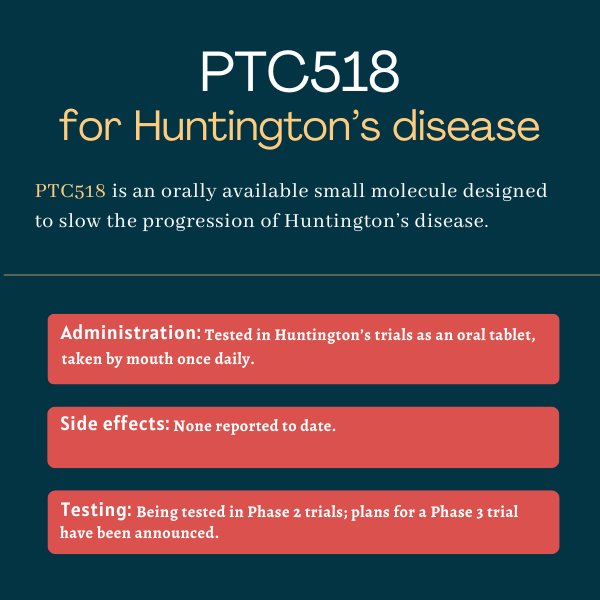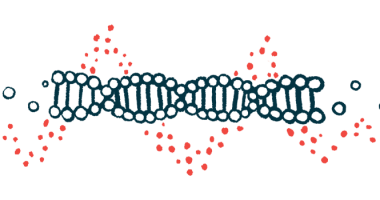PTC518 for Huntington’s disease
Last updated Feb. 7, 2025, by Margarida Maia, PhD

What is PTC518 for Huntington’s disease?
PTC518 is an investigational oral therapy being developed to slow the progression of Huntington’s disease.
Originally developed by PTC Therapeutics, the treatment’s global rights were acquired by Novartis in late 2024.
PTC518 was granted fast track status in 2024 in the U.S. for treating Huntington’s. The designation is meant to speed the development and regulatory review of medications that might fill unmet medical needs in serious or life-threatening conditions.
Therapy snapshot
| Treatment name: | PTC518 |
| Administration: | Being tested in Huntington’s as an oral tablet |
| Clinical testing: | Currently being tested in Phase 2 clinical trials; poised for a Phase 3 study |
How does PTC518 work in Huntington’s disease?
Huntington’s is caused by mutations in the HTT gene, which provides the code for producing the protein huntingtin. The HTT gene contains CAG repeats, a series of three DNA building blocks that normally appear 10 to 35 times in a row.
In Huntington’s, these CAG repeats are typically copied 40 or more times. This leads to an abnormally long version of the huntingtin protein being produced that is cut into smaller fragments that are toxic to nerve cells, causing them to stop functioning. As a result, people with Huntington’s experience a range of motor and nonmotor symptoms.
Most genes consist of protein-coding regions, called exons, that are separated by noncoding regions, called introns. Both exons and introns are copied into an early version of messenger RNA, or mRNA, an intermediate molecule derived from DNA that serves as a template in protein production. During a process called splicing, introns are removed while exons are joined together to form a mature mRNA molecule.
PTC518 is an orally available small molecule designed to reduce the production of both normal and mutated huntingtin protein by modifying splicing of the HTT gene’s mRNA molecules. During splicing, PTC518 introduces a premature stop signal that triggers a quality control mechanism that promotes the breakdown of HTT’s mRNA molecules.
Given that PTC518 is able to reach the brain and spinal cord, it’s expected to reduce the production of the faulty huntingtin protein in these regions, easing symptoms of Huntington’s and slowing disease progression.
How will PTC518 be administered in Huntington’s disease?
PTC518 is available as an oral tablet to be taken by mouth. In Huntington’s clinical trials, it’s been tested at a once-daily dose of either 5 or 10 mg, with possible future testing of 20 mg.
PTC518 in Huntington’s disease clinical trials
In a Phase 1 clinical trial, PTC518 was found to dose-dependently reduce HTT’s mRNA levels in the blood by up to 50%, along with blood huntingtin protein levels, among healthy adults. Therapy levels in the cerebrospinal fluid (CSF), which surrounds the brain and spinal cord, were at least as high as those in the blood, further confirming PTC518’s ability to reach target tissues.
Based on these findings, PTC launched a placebo-controlled Phase 2a trial called PIVOT-HD (NCT05358717) to gain proof of concept of PTC518 as a disease-modifying treatment for Huntington’s.
PIVOT-HD
The global PIVOT-HD study is evaluating the safety and effectiveness of PTC518 in up to 252 adults, ages 25 and older, with a genetically confirmed Huntington’s diagnosis and 40 to 50 CAG repeats. Eligible patients must have stage 2 Huntington’s, an early-intermediate disease phase, or early stage 3, which represents slightly more advanced disease.
Participants are being randomly assigned to receive one of two doses of PTC518 (5 or 10 mg) or a placebo, both taken as a once-daily oral tablet for 12 months, or one year.
Additional patients may be enrolled for a third treatment group, testing 20 mg once daily, should the study’s drug safety monitoring board recommend to do so based on data from the two first doses.
The study unfolds in two parts. The first part, lasting three months, will assess the therapy’s safety and tolerability, effects on blood HTT’s mRNA and protein levels, and levels in the CSF. The main goals of the second part, which lasts nine months, include changes in CSF huntingtin levels, biomarkers, and clinical measures.
Initially announced three-month data from the first 33 participants, all with stage 2 Huntington’s, showed PTC518 resulted in a dose-dependent reduction in blood levels of faulty huntingtin protein — by 21% with the lower dose and 30% with the higher dose. In contrast, patients taking a placebo had a 12% level increase in the same period.
Also, PTC518 levels in the CSF were as high as those in the blood when taken at 5 mg and about 50% higher at 10 mg.
Interim results from the first 32 patients who completed one year of treatment showed the experimental therapy continued to reduce blood levels of mutant huntingtin with longer treatment.
At one year, such levels had fallen with PTC518 by 22% in the 5 mg group and by 43% in the 10 mg group relative to the start of the study, but increased by 14% in the placebo group. CSF data showed similar level reductions with the therapy candidate, and a 9% drop with the placebo.
Treatment with PTC518 was also associated with a dose-dependent slowing of motor symptom progression, as assessed with the Total Motor Score (TMS) scale, where higher scores indicate worse motor disability.
After 12 months, patients on placebo saw a 4.9-point mean score increase, those in the 5 mg group had a mean score increase of 2 points, and those in the 10 mg group a 1.3-point increase.
The experimental therapy also resulted in less pronounced score worsening than the placebo in other key functional measures, including the composite Unified Huntington’s Disease Rating Scale and total functional capacity.
CSF levels of neurofilament light protein, a marker of nerve cell damage, remained generally stable over a year in all groups, with no treatment-related spikes. Loss of volume in the striatum, a brain region involved in motor control, was also comparable between the groups.
Extension study
Patients completing PIVOT-HD may choose to enroll in the trial’s Phase 2b long-term extension study (NCT06254482), where all will receive PTC518 for 24 months, or two years.
Those originally assigned a placebo are randomly assigned to receive one of the two PTC518 doses, whereas those already taking PTC518 continue to receive the same treatment dose.
PTC has reported that, based on the promising Phase 2a interim findings, it will start to prepare the launch of a Phase 3 study to confirm the therapy’s benefits in this patient population.

Common side effects of PTC518
In the Phase 2a PIVOT-HD trial, PTC518 has been generally well tolerated in people with Huntington’s. The most commonly reported adverse events in the trial included symptoms of common cold, the flu, headache, and falls, with similar rates between treatment and placebo groups. There have been no reports of treatment-related serious side effects or dose-limiting toxicities.
Data from additional studies will offer a better picture of PTC518’s side effect profile in this patient population.
Huntington’s Disease News is strictly a news and information website about the disease. It does not provide medical advice, diagnosis or treatment. This content is not intended to be a substitute for professional medical advice, diagnosis, or treatment. Always seek the advice of your physician or other qualified health provider with any questions you may have regarding a medical condition. Never disregard professional medical advice or delay in seeking it because of something you have read on this website.
Recent Posts
- A tribute to the kindness of strangers in life with Huntington’s
- How to support someone who is planning for future care
- Antipsychotics improve functional capacity, independence in HD
- Despite dwindling resources, hope endures among researchers
- The ‘invisible’ symptoms of Huntington’s that people don’t see
- Genetic variant delays Huntington’s onset by up to 23 years: Study
- Watching Huntington’s switch roles in our marriage was jarring
- The gift of community is what I’m most thankful for this year
- Revir wins $4.6M grant to advance oral Huntington’s treatment
- The inheritances that shape how we love, lead, and live
Related articles




